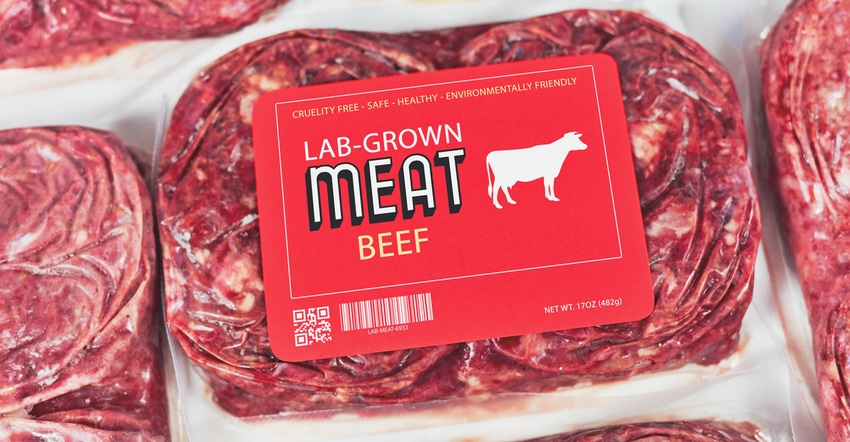December 15, 2021

Is a rib-eye still a rib-eye if it’s made in a factory instead of on a farm? Although meat and poultry have up to this point been products of animals born, raised and slaughtered, new technologies are challenging that paradigm.
Now cells can be grown or cultured in nutrients and harvested as food. Enter cultured meat, bio meat, clean meat, in-vitro meat, cell-based meat, artificial meat, fake meat, slaughter-free meat or lab meat. The question is, does it matter to you, the consumer, where the actual cells that make up your steak were grown, and should we label them differently?
The concept of cultured meat has been around since 1931, with Winston Churchill predicting the industry would move away from the “absurdity of growing a whole chicken in order to eat a breast or wing.” The vision has become a reality. Industry has been able to transform the creation of beef, lamb, goat, pork, chicken and various species of fish. And in the future, it claims it will create cell-based shrimp, breast milk and foie gras, in addition to making blends of these meats with plant-based proteins.
Consumers, traditional meat producers and emerging meat producers continue to spar over what to call this new technology meat. The U.S. government has joined the naming and labeling battle, and it wants consumer and industry input. The question is, are these cultured cells the same as traditional cells, and therefore should the government permit identical labeling, or does the methodology of growing and harvesting necessitate an alternate naming scheme?
You might be asking “What’s the beef?” Why deliberate about a name? But the debate regarding naming is similar to that of the cattle carcass trimmings that are heated to separate the fat, and hit with ammonium gas to create lean finely textured beef or LFTB, objectionably known as pink slime, which was found to meet the regulatory definition of ground beef and is now permitted to be labeled as such.
Now, when LFTB is added to ground beef, you would never know by looking at the label. But should cultured meat be labeled identically to traditional meat? Or do the benefits and costs require or permit differences? Those that advocate for cultured meat claim numerous benefits that are sometimes difficult to quantify.
Cultured meat benefits
Most often cited is the fact that the demand for animal-based food is increasing at an alarming rate, estimates of an 80% increase from 2006 to 2050, with demand for beef increasing by 95%. The amount of pastureland, water and other natural resources needed to grow these entire animals for food is grossly disproportionate to the number of calories produced.
Cultured meat would fill the need while reducing the environmental impact. Similarly, without the need for entire animals, ancillary use of pesticides, fungicides and fertilizers for crops decrease. In addition, cultured meat eliminates much of the discussion regarding animal welfare issues of living on factory farms in close confinement, the subsequent use of vaccinations and antibiotics to reduce disease outbreaks, as well as the possibility of zoonotic pandemics.
Likewise, cultured meat eliminates potential pathogenic contamination from microbes living in animal intestines such as E. coli, salmonella and campylobacter during slaughter. It also lacks the bacteria found in the digestive tract, which create transfats. Ultimately, cultured meat offers socially conscious consumers a way to feel good about their food choices without requiring a change in diet, the ultimate “having a steak and eating it too.”
Cultured meat drawbacks
Opponents to cultured meat argue it will negatively affect farmers, ranchers, processors, transporters and the chemical and pharmaceutical industries financially. They disagree that less resources will be used in the production of cultured meat, because animals eat plants that convert energy from the sun, while bioreactors need their own input for cultured meat to grow.
Moreover, cultured meat technology has focused on muscle cells, but continues to struggle to incorporate fat cells, blood vessels, nerves and connective tissue, which alter the taste, mouth feel, juiciness, nutrition and appearance.
One vitamin in particular, B12, which is a product of specific bacteria that colonize the intestines, would be absent. Difficulties also arise when attempting to create various cuts of meat from various anatomical locations, a chuck roast versus a tenderloin. Likewise, opponents argue the various types of cells used are difficult to obtain, difficult to keep dividing, and sensitive to changes in the culture media. Also, the favored culture media is fetal bovine serum, otherwise known as calf blood, which is unacceptable to vegetarians and seemingly unpalatable.
These consumer perceptions and acceptance issues will be difficult to overcome. Various studies are conflicting in terms of whether the technology of cultured meat will be able to overcome notions of unnaturalness, health concerns, food safety and price. The arguments for and against are just the tip of the naming dilemma, because the goal in a name is to inform consumers about the nature of the product.
Consumer input wanted
USDA’s Food Safety Inspection Service is asking for consumer and industry input on naming these various meat products. The goal is to collect information to enable USDA to promulgate regulations for labeling these products that are based on science, as well as consumer and industry input.
Ultimately these regulations will provide guidance to industry so that it can create labels that are not false or misleading in any particular pursuant to current law. Be part of the decision-making process before the products are on your table. Visit regulations.gov to read more about the request and click comment on the left side of the page.
Kris DeAngelo is an attorney and educator with MSU's Institute for Food Laws and Regulations.
You May Also Like




